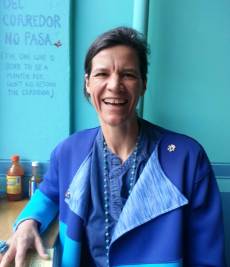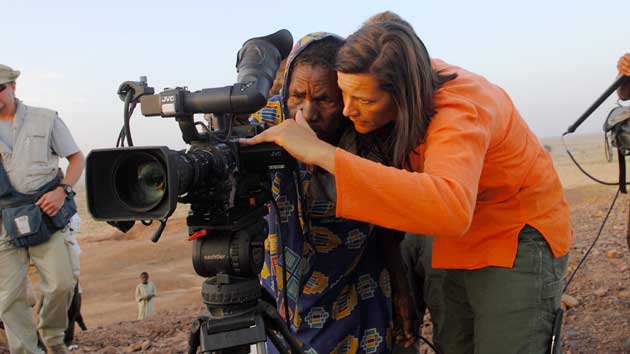
A Filmmaker's Responsibilities, Ways of Understanding the World, and a Life in Documentaries
Kirsten Johnson has directed three films, but she's best known as a "cameraperson," as she describes herself and titles her new feature. Cameraperson compiles footage from decades of work across the globe. Johnson has traveled to remarkable and troubled places: Nigeria, Bosnia, Afghanistan. Her film ventures from her own apartment to these hot spots. All the while, she reflects obliquely on the responsibilities of filmmakers towards the people they shoot, raising thought-provoking questions without easy answers. Footage included in the film was shot on a variety of cameras over the course of more than 10 years.
Studio Daily talked to Johnson in the Criterion Collection offices in New York in August.
StudioDaily: How do you think your life would’ve been different if you’d worked on narrative films?
Kirsten Johnson: What an interesting question! I’m not sure I can even imagine that. I hope that I would’ve been as engaged with the world as I feel that I am with documentaries. I hope I would’ve gotten the chance to enter so many different worlds, because I know I am changed profoundly by having access to going to different countries, or a prison. The camera gives you permission to go to these worlds that you don’t have as an individual. I hope I would’ve found directors who would’ve taken me to these worlds. Why do you ask this? What’s in the question for you?
It occurs to me that you wouldn’t have done nearly as much traveling and you would’ve worked with a lot more male directors.
I was thinking that in my response. In some ways, there have been no boundaries on the range of people I’ve engaged with. In the narrative world, there are a lot more limitations on the people you engage with at this moment in history. I think that’s going to change at a more accelerated pace.
Despite the information you give, there’s still an enigmatic quality to Cameraperson. Was it hard to find that kind of balance?
Very much so. There was a part of me that wished I could be sure people understood certain things. I wanted people to care about certain things in the way that I cared about them. It became very interesting to me to realize how much evidence there is in the footage. It really depends who the audience is, how much they can read or not read. If you’re a doctor, you know something different about the midwife and baby in Nigeria. If you’ve had a baby, you know something different. All of your life experience leads to different conclusions. Some of it’s very clear. The axe scene with the little kid in Bosnia didn’t have the same dramatic effect for Bosnian audiences because, someone told me, “All kids in Bosnia learn how to use axes at a very young age.” That was the most banal thing for them. When you say “enigmatic,” I’d rather think “open.” It’s open to the many different ways of understanding it that exist.
Have you traveled around the world with the film?
I’ve just started. I was in Bosnia, Kosovo and England. I really hope someday I get to show it in Nigeria, and I would love to show it in Afghanistan. I’m hoping it lives long enough for me to track down everyone who appears in it and show it to them.
I know that you spent several years working on a film in Afghanistan, then your subject said it would be unsafe for it to be shown in public. I can perfectly understand why, but that must have been a blow to you. Is any of the footage not featuring her in Cameraperson?
There’s one shot of her walking down the street from behind. You see her hijab. The shot of the Ferris wheel with the one-eyed boy was also from that film.
Was there anything specific that she did or said in the film, or is it just that visibility is dangerous for Afghan women?
It was both things. It was also that anyone who is living in the middle of a conflict situation is hedging all their bets. She was really young when she started filming with me and had a lot of hope about the situation and the freedom that would be possible. By the time I finished making the film, her hope had started to change. The really key part is that the world had shifted. The promises we used to make about “Oh, that film won’t be seen in your town” had ended. Footage could be seen anywhere in the world. So that, for me, is the big thing I’m thinking about now as how we act as camerapeople. The fact that footage we shoot can be disseminated anywhere in the world changes many dynamics.
Who are some of your favorite documentarians?
Well, I think immediately of [Restrepo co-director] Tim Hetherington, who is no longer alive. I wish he could still make more of my favorite documentaries, because I love his short film "Diary." [Vimeo] For me, it was like someone had looked inside my mind, because he had traveled to many of the places I had been: Liberia, Afghanistan. He managed to make this non-verbal film that conveyed the feeling of coming and going between all these realities. It was so shocking to me that he could translate that experience that those of us who travel a lot share. I was looking forward to what he would make next when he was killed. In some ways, it gave me a sense of courage about making something myself, because he wasn’t going to get a chance to do it. Much earlier, I had my breath taken away by Chris Marker and Sans Soleil. Those questions that he raised for me the very first time have stayed with me my entire career. There’s a set of documentarians who think about what we do with the camera as we move about the world. Dziga Vertov and Man With a Movie Camera still feel alive to me. I feel the same way about Buster Keaton. I think of Keaton as a documentarian because he did his own stunts. It’s a documentation of what it did for him to do that thing in reality. That’s the kind of filmmaking I’m really inspired by.
Is the title Cameraperson an allusion to Man With a Movie Camera?
No. I think it evokes it. But it’s what I call myself. Every day that I’m working, someone calls me a “cameraman.” I filmed at the Democratic National Convention, and my credentials literally say “cameraman” on them. And so for a long term, I called myself a “camerawoman.” Then I switched to “cameraperson.” It’s a word that can encompass everything I’m trying to think about with the work. Making this film was such an intimate search that I would never put it in the same category as Man With A Movie Camera. I couldn’t imagine aspiring to be in the same company as it. It’s too far away from my journey.
Did you start out working with 16mm and 35mm?
In film school in France, we worked with 35mm cameras. The first documentary I worked on, we used 16mm cameras. I remember really distinctly being in the middle of a riveting interview and having the film roll out and the feeling of complete impotence and impossibility. I was beating myself up, wondering, “Why did I choose to roll when I rolled?” You wouldn’t even know if you had exposed it correctly. You’d be waiting, in this period, for the film to come back. It was a great present if the exposure was correct. That mystery and thrill has gone with video.
So you prefer working with video?
It’s just been my moment in history to work with it. I have been alive when we used standard-definition cameras. When I look at the cameras we have now, I wish my entire career had been spent working with them. Yet it’s the time when I got the chance to be a cameraperson. I embrace it.
Do you know what happened to the soldier in the Michael Moore outtakes [Corporal Abdul Henderson, USMC, from Fahrenheit 9/11; he declares that he’s thinking of deserting rather than going back to Iraq]?
Johnson: We reached out to him, and he was actually going to go to Moore’s film festival in Traverse City [MI]. There were bad weather conditions, so he couldn’t make it. But I’ve spoken to him, and he’s seen the film. I don’t know exactly what happened to him at that moment in time, but he’s actually become the executive director of the Congressional Black Caucus. He’s doing extremely well. I’m really looking forward to meeting and talking with him, I was delighted to learn what’s become of him.
A lot of the discourse around your film is about filmmakers' responsibility towards the people they film. It’s expressed most explicitly not by you but by a Syrian journalist [Charif Kiwan]. Do you agree with everything he says?
No, I don’t. I respect what he says. I brought him in the film to express one end of the spectrum. Sometimes we film indecent or horrific or impossible images, and it’s deeply meaningful. I dedicate the film to three people. One of them is Marnie Mobley. Her son Emmett Till was killed and beaten, and she chose to open the casket. She decided to show his beaten body. I think Charif would say, “Don’t show his body.” I think that attitude doesn’t make sense in that context. Her decision changed many things and was also full of grief and questioning. Charif is in the middle of a war, where taking a principled stance becomes necessary. I also think it’s wishful thinking that you can be sure and principled all the time. In war, you gravitate towards such a stand. Many of my Syrian filmmaker friends question Charif’s point of view and speak about how important it is to show Syrian bodies. I respect all these positions.
When Al Jazeera was still available in New York, it was noticeable that their broadcasts were more gruesome than American-based cable news. They didn’t show corpses, but they did show blood in the street.
I have deep respect for what it does to us as humans to see violence. It impacts us strongly. I think it can be used in the service of misinformation or political ideology. We can take in imagery of others without respect for their humanity. When we film images of violence, we have to consider how we use them. I’m very interested in people who talk about what it means to show violence, and I’m also interested in the spikes in terrorist attacks and mass shootings when there’s a big impact around these things. We all contribute to imagery these days. We all have phones in our pockets. Moments of brutality can be shown that never could be shown before. Police brutality can be live-streamed on Facebook. That’s never existed in history before. Thinking about power in relation to images of violence is really crucial. I’m not a person with the answers about it, I’m a person with questions.
Cameraperson opens tomorrow at the IFC Center in New York City and on September 23 at the Laemmle Royal in Los Angeles.
Did you enjoy this article? Sign up to receive the StudioDaily Fix eletter containing the latest stories, including news, videos, interviews, reviews and more.









